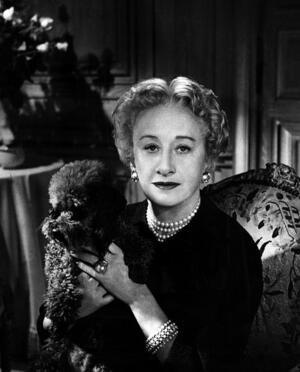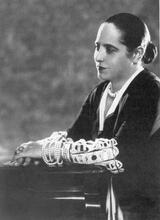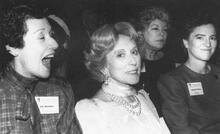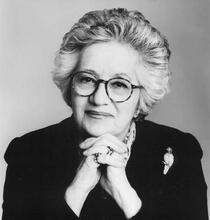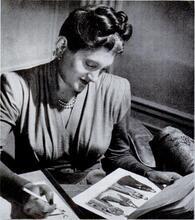Hattie Carnegie
Hattie Carnegie was a leader in American fashion for three decades, designing clothes with a blend of simplicity and elegance. She partnered with seamstress Rose Roth in 1909 to create a custom clothing shop and bought out her partner in 1918. Carnegie both sold her own designs and travelled regularly to Paris to import clothing by Chanel, Dior, and other top names in couture. In 1925, she became the first custom designer to create special collections for wholesale to department stores. Carnegie’s work ranged from designing uniforms for the Women’s Army Corps to one-of-a-kind creations for clients like the Duchess of Windsor, Clare Booth Luce, Tallulah Bankhead, and Joan Crawford. In 1948, she was honored with the Coty American Fashion Critics Award.
We have the loveliest women in the world in this county and wherever there are beautiful women there will be beautiful clothes. To show the American woman herself off to best advantage—that has always been my aim and that is my real biography.
—Hattie Carnegie
Hattie Carnegie led a fashion empire that set the pace of American fashion for nearly three decades. She imported Paris designs, produced custom designs and a ready-to-wear collection, and sold other designers’ ready-to-wear. Even women who could not afford to buy Carnegie originals felt the influence of her style in the many mass-market copies of her work. Carnegie made numerous trips to Paris every year, buying and importing the models of designers such as Vionnet, Lanvin, Chanel, Dior, Molyneux, and Schiaparelli.
Early Life & Family
Hattie Carnegie was born Henrietta Kanengeiser, the second of seven children, on March 15, 1886, in Vienna, Austria. In 1892, she immigrated with her family to New York’s Lower East Side. She changed her name to Carnegie by 1909, naming herself after the richest person in America, Andrew Carnegie. In 1927, she married Major John Zanft, a childhood friend from the Lower East Side, after two other brief marriages. Zanft was involved in the motion picture industry; he was a former vice president of Fox Films.
Fashion Career Beginnings
Carnegie formed a partnership with Rose Roth, a seamstress, in 1909. They started a custom clothing and millinery shop on East 10th Street in New York City. By 1913, they had incorporated and moved their shop to a more fashionable location, on West 86th and Riverside Drive. During this time, fashion leaders Mrs. Harrison Williams and Mrs. William Randolph Hearst became her clients. In 1918, Carnegie bought out her partner. In addition to selling her own designs, she began to travel to France and bring back Parisian fashions that she restyled and remodeled for her American customers.
Over the next twenty years, Carnegie traveled to Paris as many as seven times a year to study and buy current fashions. In 1923, Carnegie moved her business to a townhouse at 42 East 49th Street. This location remained the seat of her custom business. The store sold furs, jewelry, lingerie, perfumes, and accessories in addition to clothing. The Carnegie look embodied total perfection, and her accessories were as much a part of the “look” as the clothing. In the 1940s, she created the Blue Room, where she sold her own and other manufacturers’ ready-to-wear lines. Her innovative Jeune Fille department (created in 1941) provided lower-priced clothing for her younger customers.
Wholesale Business

She couldn't sew or cut a pattern herself, yet Hattie Carnegie's sense of style and taste sparked her rise from humble beginnings as a Jewish immigrant to the creator of a fashion empire around a distinctly "American" look. This photo was taken during the mid-1900s.
Institution: Library of Congress.
In 1925, I. Magnin was the first store to buy Hattie Carnegie designs wholesale. These designs carried the I. Magnin label and the Hattie Carnegie label. Carnegie is known as the first custom designer to create special collections for a ready-to-wear label for wholesale trade. “Hattie Carnegie Originals” were produced in Carnegie’s own factories. She ran her wholesale business at 711 Fifth Avenue.
Carnegie could not sew or cut a pattern herself, but she had an eye for gathering talented people to work for her. Many of the designers who worked for Hattie Carnegie emerged as important designers and arbiters of style on their own. Pauline Potter (later Baroness Philippe de Rothschild), Norman Norell, Claire McCardell, James Galanos, Jean Louis, and Travis Banton all began their careers under the direction of Carnegie. Acting as a great editor of style and taste, Carnegie brought out the best of her designers’ talents. Carnegie maintained regular customers among America’s most prominent socialites and Hollywood and Broadway stars. Clients included the Duchess of Windsor, Barbara Hutton, Clare Booth Luce, Constance Bennett, Tallulah Bankhead, Joan Crawford, Gertrude Lawrence, and Norma Shearer. Her best known works were her “little Carnegie suits.” Carnegie’s suits typified a style that was neither youthful nor matronly, but very feminine and very neat—the “Carnegie Look.” Carnegie claimed in 1951 that “there is really no ‘Carnegie Look,’ there is only the ‘you’ look. My clothes are built to show off the woman who wears them. I like them to be simple, complicated and simple, to move well, to move with the times and a little ahead of them. The dress itself should never take over. On the contrary a woman should feel so at ease in her clothes that she can forget all about them” (Lambert).
Legacy
In 1948, Carnegie received the Coty American Fashion Critics Award. She received the United States Army’s highest civilian award for designing the Women’s Army Corps uniforms.
Hattie Carnegie died at age 69 on February 22, 1956, in New York. Her multimillion dollar fashion business continued into the 1970s, but the strength of Carnegie’s personal dynamism and leadership was so closely identified with the company that it was difficult for it to continue successfully without her. Two of Carnegie’s brothers had worked closely with her in her business. Tony managed the wholesale dress business, and Herman managed her financial affairs.
The Carnegie look defined the American desire for a style that is discreet, simple, and sophisticated. Her career began at a time when Americans looked almost entirely to French haute couture for direction. When French fashion became unavailable during World War II, Carnegie continued producing high-quality clothing with the best American fabrics and designers. Carnegie’s work as a great editor of French haute couture for the American market as well as her extraordinary record of recognition and development of American talent place her firmly at the forefront of the development of American style in the twentieth century.
Bauer, Hambla. “Hot Fashions by Hattie.” Collier’s. April 16, 1949.
DAB 6.
“Hattie Carnegie.” Current Biography. October 1942.
“Hattie Carnegie: American Style Defined.” Exhibition. The Museum of the Fashion Institute of Technology, NYC. February 16-April 27, 1996.
Lambert, Eleanor, “Hattie Carnegie: Biography.” Press release. New York Dress Institute, 1951.
“Luxury, Inc.” Vogue. April 15, 1928.
Milbank, Caroline Rennolds. New York Fashion: The Evolution of American Style. New York: Harry N. Abrams Inc., 1989.
NAW.
New York and Hollywood Fashion: Costume Designs from the Brooklyn Museum Collection (1986).
Obituary. NYTimes, February 23, 1956, 27:1.
Steele, Valerie. Women of Fashion: Twentieth Century Design. New York: Rizzoli, 1991.
WWWIA 3.

